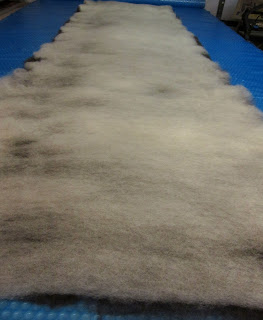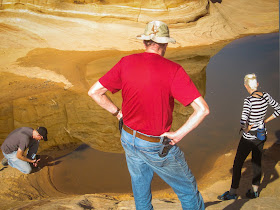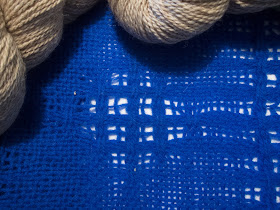This is a piece I wrote to present to my local weaver's guild after we had woven a napkin exchange. I don't remember if the information ever got into the newsletter. Anyway, it has some interesting things for us to consider when we plan and weave our projects.
1. Repair
heddles are great and worth the price.
When I set up my looms, I have a specific number of
heddles on each shaft. I determine this
number based on what I usually use. I have
flat steel heddles and they add weight to the lifting so I want to keep the
weight down.
As you know the heddles have an up and a down and a right
and a left and there are two types that alternate when you have them on
correctly. Having the heddles on
correctly makes threading faster and easier for me.
When I planned this warp, I needed 74 heddles on four of
the shafts and 76 on the other four.
This loom has 75 heddles on each shaft, so I knew I needed to add to
four shafts. Usually when I add shafts I
add them in groups of 25 (that is the number of heddles in each group I
store). Adding heddles is a lot of work,
and for only one heddle, I decided to just add a repair heddle. You can tie in a string one, but in my case I
found 4 repair heddles that I have to fit this loom. It took about 5 seconds each to slip the
heddles on and I did not have to remove anything from the loom/shafts to do
it. I love repair heddles and they are
worth the price.
2. Wind the
bobbins, pirns, or quills well for easier weaving.
A well wound source of yarn that is not loose, will help
the weaving be more even. To wind a
quill, you need to know a few things.
The heavy paper you use for the quill should be about ¾” shorter than
the bobbin space in your shuttle. I like
to have the length of the paper about 1½ times the width of the paper. When you wind you need to start by building
up the ends. These bulges replace the
flanges on the bobbins that you buy. You want to build it up to be just smaller
than the opening for the bobbin. I need to be careful building these, I hate it when the ends of the quill collapse When
the two sides are built up, fill in the center.
You want to add tension to the yarn so each layer that you build does
not dig into the layers below it. (If
you wind it too loosely, the upper layers dig in and then don’t feed out evenly
when you are weaving.)
Bobbins, quills, or pirns –
the way you wind them will determine how even your thread feeds out and how
even and pleasurable the weaving is. The finer the yarn is the more this
matters.
On pirns, you need to wind
in a continuous cone shape. Start at the
wide end of the pirn and build the shape across the length, do not back up to
fill in the narrow sections, just continue building the cone to the end.
3. Test the
sett, but it doesn't always help
because different types of yarns beat differently.
As I was putting the warp on about 2 weeks ago, I did not
put a sample warp on to test the sett. I
went by the instructions given, which was just a general suggestion. With the pattern that I used, I probably
should have used a more open sett. Due
to this closer sett warp, I need to do a very hard double beat to come close to
squaring my pattern. Also, the Webs pearl cotton was harder to beat in. Is this
difficulty because the yarn is a little bit thicker, or because the twist is
tighter, or because the twist is the opposite direction? And will that direction of twist change the
look of the pattern? That is a lot to
think about.
4. After you
figure your warp requirements, wait a few hours and recheck them.
By
miscalculation I received 8 different yarns, but only gave out 7 of mine. I knew this but at the time I was figuring my
amounts (two weeks ago in a rush), I didn't take that into consideration. I had planned on having 12 napkins and so I
figured the amounts for 12 napkins, instead of the 13 I needed to weave. I also messed up with the take-up. For some reason having the on loom width of
20 (I didn't have to figure shrink and take-up), I didn't figure shrink and
take-up on the length. Big mistake on my
part, because I got 11½ napkins instead of the 13 I had wanted to weave so that I would have a set
of 12. I didn't realize the math mistake
until the warp was almost woven and the weaving was not long enough. I checked back on my math figuring and found
the glaring mistake. Oddly enough I made
this mistake the same week I was teaching “Figuring your Warp” in my beginning
weaving class. I always tell my students
to get an experienced weaver to check the math if you are not sure. So I want all of you to be aware, next time I
figure a warp, I may be giving you a call to check my thinking.
5. Check your
loom and keep it in good condition. Sudden changes in warp tension may not be
your fault.
Near the end of my warp, I suddenly got badly loosened
tension on the left side of the weaving.
I looked over the loom to the back beam and warp beam to see if I could
see a problem in the warp. What I saw
was a bolt on the floor! All of that
hard double beating of the warp had loosened the bolt and nut at the back. Of course, I was not able to find the barrel
nut. I’m sure my vacuum will find it
later to its detriment. I went digging
around in my tool box and found another nut.
I loosened the warp, adjusted the loom and unwove about 5 to 6 shots to
get back to the even weaving. This
experience reminded to tighten the screws and bolts in you loom before you
start a project and after you finish it so that your loom stays in working
condition. (A good vacuum job to keep
the dust off the loom, and controls the dust bunnies under the loom is also a
good goal.)




































.jpg)







.jpg)
.jpg)








